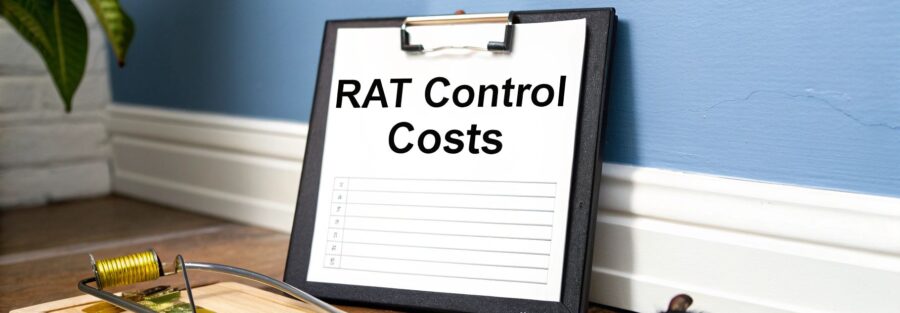So, you've got a rat problem. The first question on your mind is probably, "How much is this going to cost me?"
In the UK, you can expect professional rat control to cost anywhere from £120 to £240 for a standard treatment. Most homeowners find themselves paying somewhere around the £180 mark. But that's just a ballpark figure.
Think of it like getting a quote from a garage. The initial price covers the basics, but the final bill depends on what the mechanic finds under the bonnet. Is it a quick fix or a major overhaul? The true cost of sorting out a rat problem depends entirely on the scale and complexity of what's happening behind your walls.
Your Quick Guide to UK Rat Control Costs
A straightforward issue in an easy-to-reach spot? You'll likely be at the lower end of that price range. A widespread infestation that demands multiple visits, detective work, and specialist gear will naturally cost more.
This guide is here to give you a realistic idea of the investment needed to get your home back.
Breaking Down the Numbers
To help you get a clearer picture, let's look at how different parts of the job add up. While a single treatment has an average price, a proper, lasting solution often involves a few different steps.
Professional rat control costs in the UK are shaped by the size of the infestation, your location, and the methods needed to sort it out. A typical job includes an initial survey, setting traps or bait, and follow-up visits to make sure the problem is gone for good. You can find more details on the factors that influence pricing over at MyJobQuote.co.uk.
One of the biggest mistakes people make is thinking a single visit will solve everything. With a persistent pest like the brown rat, a multi-visit approach is almost always essential to make sure the entire colony—including any new babies—is completely dealt with.
To give you an at-a-glance overview of the potential investment, here’s a breakdown of what you might expect to pay for various services.
Estimated UK Rat Control Service Costs
Here's a table outlining the typical costs for the different stages of professional rat control. It’s a handy reference to see what’s involved at each price point.
| Service Type | Average Cost Range | What It Typically Includes |
|---|---|---|
| Initial Survey & Assessment | £70 – £120 | A professional inspection to identify entry points, nest locations, and the scale of the infestation. |
| Standard Single Treatment | £120 – £240 | Placement of baits or traps in key areas, usually including one or two follow-up visits. |
| Comprehensive Removal | £250 – £500+ | An intensive multi-visit plan for severe infestations, often combining trapping, baiting, and monitoring. |
| Full Proofing Service | £200 – £600+ | Sealing entry points with durable materials like wire mesh and cement to prevent future access. |
Remember, these are estimates. The best way to know for sure is to get a professional survey, which gives you a clear plan and a firm quote based on your specific situation.
What Really Drives Your Final Rat Control Bill
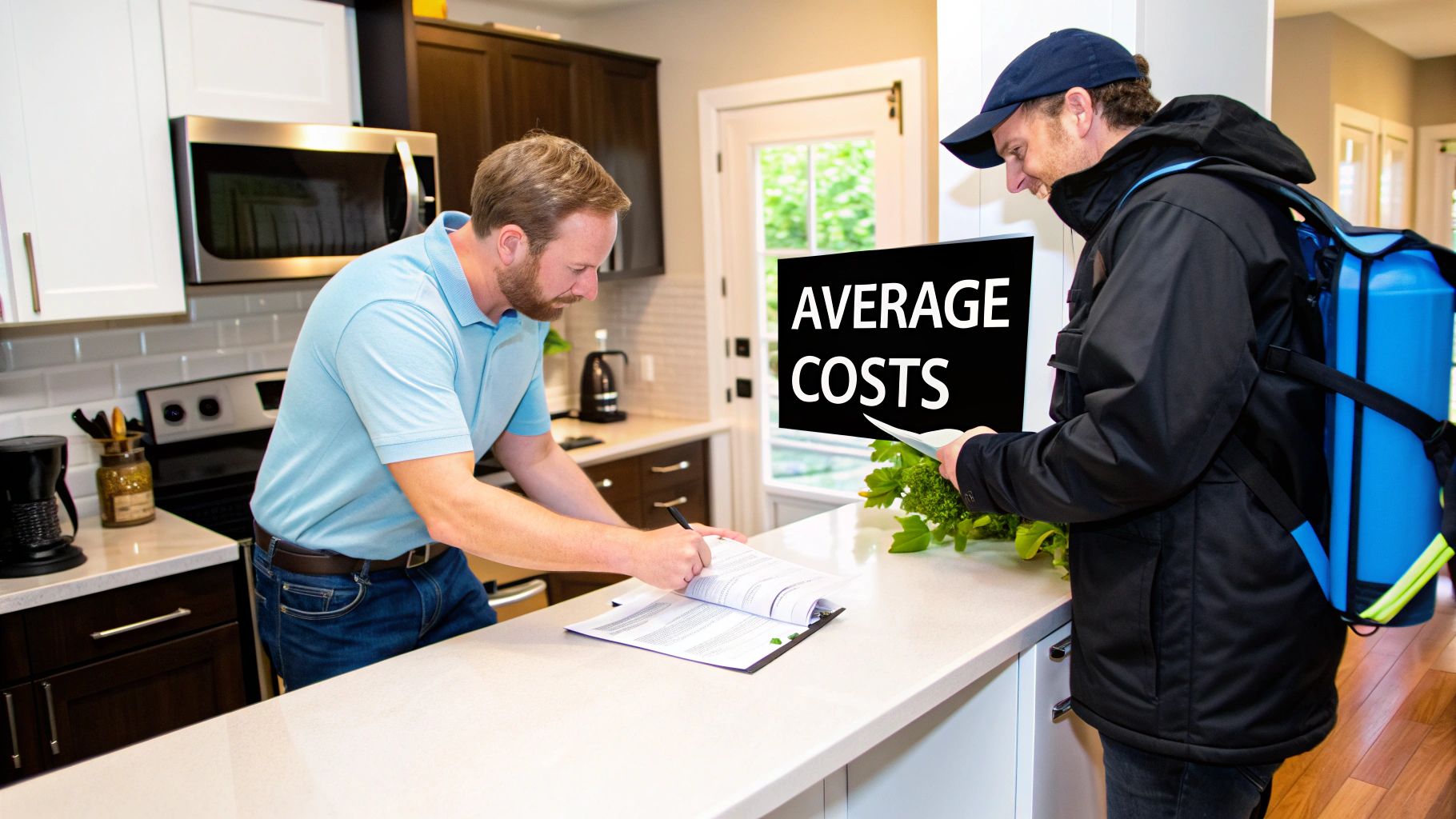
Knowing the average cost of rat control gives you a good starting point, but the final figure on your invoice is shaped by what’s actually happening in your property. Think of it like a taxi fare: there's a base rate, but the final price depends on the distance, the traffic, and any unexpected detours. Your specific situation dictates the true cost of getting your home rat-free.
The quote you receive is a direct reflection of the job's complexity. A single rat spotted in the garage is a much simpler fix than a hidden, breeding colony that's turned your loft insulation into a fortress. Each scenario demands a different level of effort, resources, and time—all of which influence the final bill.
The Scale of the Infestation
The biggest driver of cost is, without a doubt, the severity of the infestation. Are we dealing with a lone explorer, or have you got a well-established family squatting in the walls? A small, localised issue can often be sorted with a couple of strategically placed traps or bait stations over one or two visits.
A large-scale infestation, however, is a different beast entirely. It tells us that rats have been there for some time, likely breeding and creating multiple nests. Tackling this requires a much more intensive approach, involving numerous visits, extensive monitoring, and more control products. It’s simple, really: the more rats there are, the more work is needed to guarantee every last one is gone.
A single pair of rats can produce up to 2,000 descendants in just one year under ideal conditions. This is why getting on top of a small problem quickly is far more cost-effective than letting it spiral into a major crisis.
Property Size and Complexity
The size and layout of your property also play a huge part. A small, two-bedroom terraced house has far fewer hiding spots and entry points than a rambling, detached countryside home with various outbuildings.
A larger property simply takes more time to inspect thoroughly and needs more materials—traps, baits, monitoring cameras—to cover all potential rat hotspots. Complicated layouts with crawl spaces, cellars, and cluttered lofts also make the job more challenging and time-consuming for the technician, which is naturally reflected in the price.
Key property features that can increase costs include:
- Multiple outbuildings: Sheds, garages, and workshops all need inspecting and treating separately.
- Complex architecture: Voids in walls, suspended floors, and tricky attics provide endless hiding places for rats.
- Proximity to water sources: Properties near rivers or sewers can face more persistent rat pressure from the surrounding environment.
Treatment Methods and Proofing
Finally, the treatment methods we use and the extent of any required proofing work will heavily influence the final cost. Basic trapping or baiting is the standard, but sometimes the situation calls for more. For example, if rats are getting in through the drains, a specialist drain survey and a one-way valve might be the only permanent solution.
Crucially, long-term control isn't just about removing the current rats; it's about stopping them from ever coming back. This is where rodent proofing comes in. Sealing entry points is a vital investment. This can range from installing simple guards over air bricks to more complex work like cementing holes in the foundations. Professional mesh air brick covers are a great example of how these simple measures work to deny rats access.
While proofing adds to the initial cost, it saves you a fortune in money and stress down the line by stopping the cycle of re-infestation for good.
Comparing Professional Treatment Options and Their Costs
When a pest control expert turns up at your door, they’re not just bringing a single solution; they’re carrying a whole toolkit of methods designed to tackle your specific rat problem. Understanding what these are and how they affect the price is the key to making a smart decision. It’s never a one-size-fits-all job – it’s about choosing the right tool for the job, balancing getting rid of the rats now with stopping them from coming back later.
Think of it like dealing with a leaky pipe. You can put a bucket under the drip to manage the immediate problem, or you can hire a plumber to find the source of the leak and fix it properly. Each approach has its place in a solid pest control plan, and the final bill will reflect the combination of services you actually need.
Reactive vs Proactive Solutions
Most professional strategies boil down to two types: reactive treatments that deal with the rats already in your home, and proactive measures that prevent new ones from getting in. A good pest controller will almost always recommend a blend of both for the best, most lasting results.
- Trapping (Live and Snap Traps): This is the most direct way to remove rats that are already inside. Snap traps are designed to provide a quick, humane end, while live traps allow for relocation. It's a great approach for smaller, contained infestations, but it does mean someone has to regularly check and reset the traps.
- Bait Stations (Rodenticides): Professionals use commercial-grade poisons housed in tamper-proof bait stations. These are carefully placed along known rat runs and are incredibly effective for getting larger populations under control. The locked stations ensure the bait is contained, making it a much safer option for homes with children and pets.
Choosing the right method is always a balancing act between effectiveness and safety. While rodenticides are powerful, a skilled professional knows how to use them in a way that minimises any risk to pets, wildlife, and the environment.
This image gives a quick rundown of the average cost ranges you can expect for different types of services.
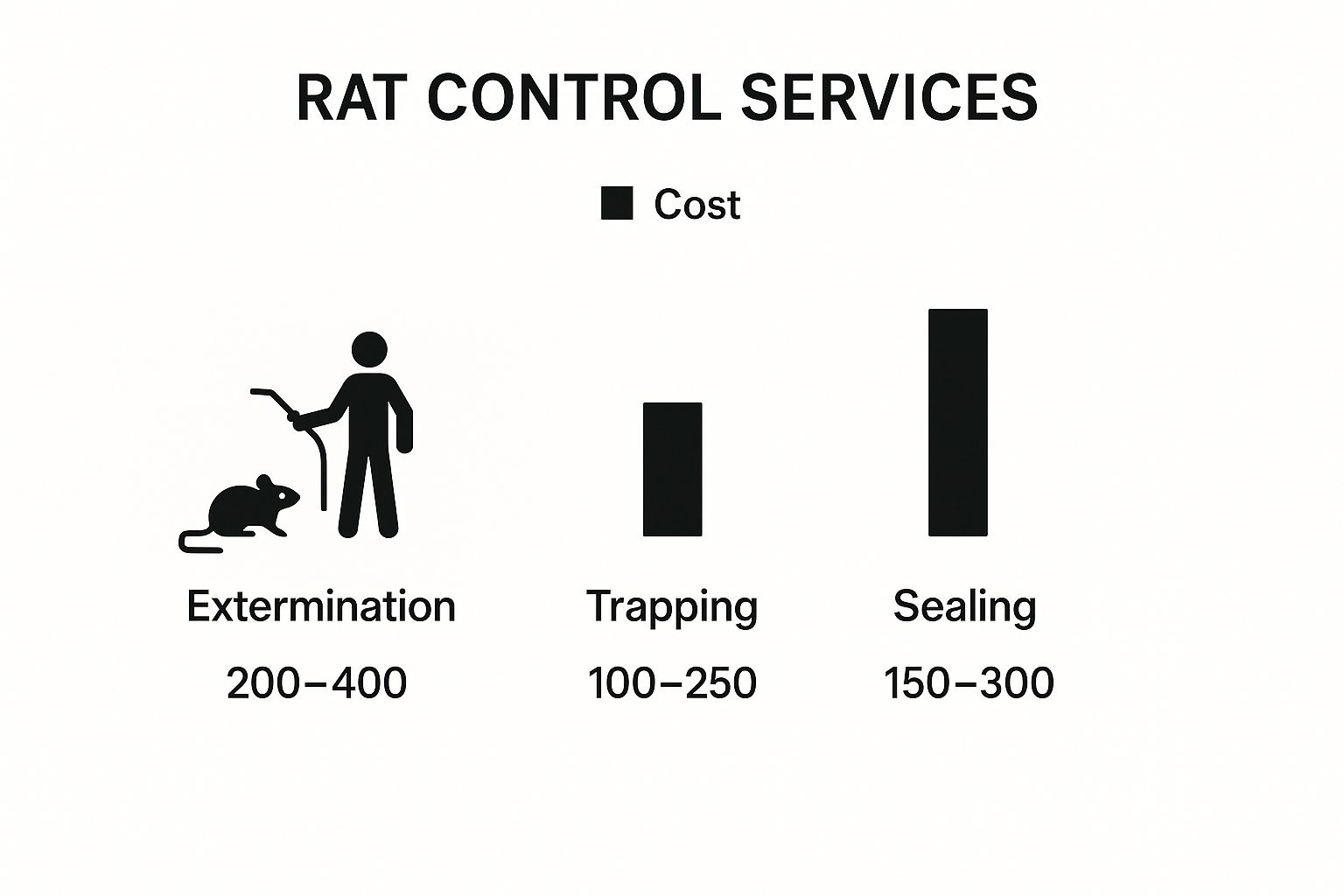
As you can see, while trapping might be a cheaper first step, a full extermination combined with sealing entry points represents a more significant investment, but one that's built to last.
To help clarify things, here's a table comparing the most common treatment methods.
Comparison of Rat Control Treatment Methods
| Treatment Method | Typical Cost | Best For | Key Considerations |
|---|---|---|---|
| Snap/Live Trapping | £150 – £300 | Small, localised infestations; situations where poison is not an option. | Requires multiple visits to check and reset traps. Slower for large populations. |
| Bait Stations (Rodenticide) | £200 – £450 | Larger, more established infestations in lofts, wall cavities, or gardens. | Highly effective but requires professional placement to ensure safety for pets and non-target wildlife. |
| Rodent Proofing | £250 – £700+ | All properties, as a long-term preventative measure. | Higher upfront cost but offers the best long-term value by stopping future infestations. |
| Combined Approach | £400 – £800+ | Most situations where rats are already present. | The most comprehensive solution, tackling both the current problem and its root cause. |
This comparison highlights that while some methods are cheaper upfront, they might not solve the underlying issue.
The Ultimate Long-Term Solution: Rodent Proofing
Trapping and baiting are great for dealing with the rats you have right now, but they do absolutely nothing to stop new ones from moving in once the coast is clear. That’s why the most crucial part of any professional service is rodent proofing. This is all about finding and sealing every single potential entry point into your home. This is the "cure" that stops the problem from ever happening again.
Proofing involves using tough, gnaw-proof materials like galvanised wire mesh, specialist cements, and metal plates to block gaps around pipes, air bricks, and cracks in the foundation. It definitely adds to the initial cost, but it provides by far the best long-term value for money by breaking the cycle of infestation for good. A properly sealed home is your best defence.
Most homeowners find that the most cost-effective path is to combine an initial extermination with thorough proofing. You can explore the various pest control services that cover both immediate removal and permanent prevention. This ensures you’re not just reacting to a problem, but actively stopping it from coming back.
The Hidden Financial Toll of a Rat Infestation
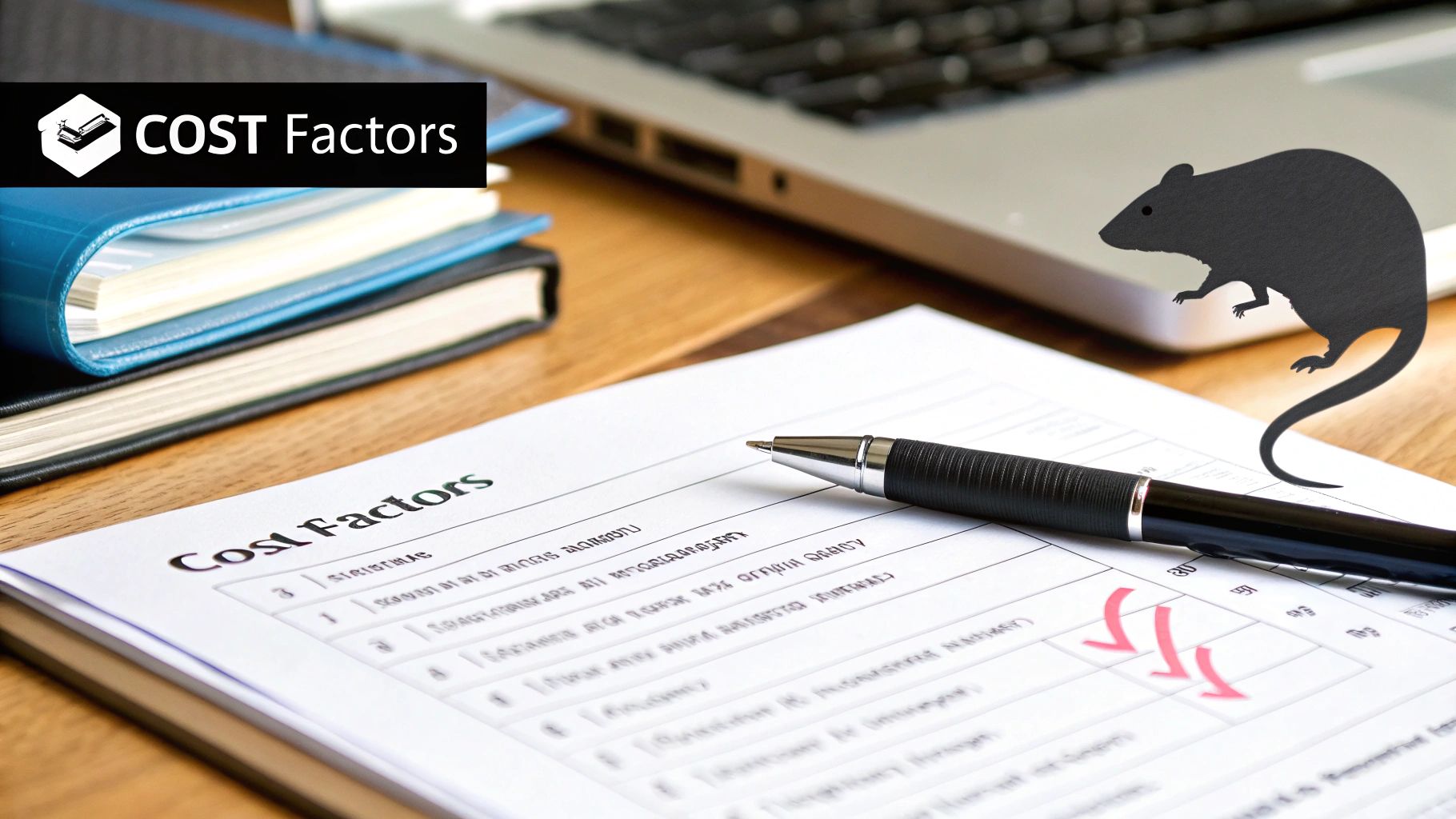
When you spot the first signs of rats, your mind probably jumps straight to the cost of getting rid of them. But that initial pest control invoice? That’s often just the tip of the iceberg. The real financial damage from a rat infestation runs much deeper, impacting the very structure and value of your property.
It’s easy to see professional pest control as just another expense, but that's a mistake. Think of it as an essential investment. The longer rats have free run of your home, the more they’ll cost you in ways you never saw coming.
Property Damage That Hits Your Wallet
Rats have a biological need to chew. Their front teeth never stop growing, so they instinctively gnaw on hard surfaces to keep them filed down. Unfortunately for homeowners, those surfaces often include the most critical parts of a house.
This non-stop gnawing can trigger a whole host of expensive repairs:
- Electrical Wiring: Chewed wires are a massive risk. It’s not just about power cuts or short circuits; this is a serious fire hazard that could have devastating consequences.
- Insulation: Rats absolutely love tearing up loft and cavity wall insulation to create cosy nests. This destroys your home’s thermal efficiency, leading to much higher energy bills as your heating works overtime to compensate.
- Structural Timbers: Over time, their constant gnawing can weaken wooden joists, beams, and other structural supports, putting the integrity of your home at risk.
- Plumbing and Pipework: Plastic water pipes are no match for a rat’s teeth. A single chewed pipe can lead to leaks, serious water damage, and a very expensive plumbing bill.
The damage goes far beyond a few scuffs and scrapes. A single frayed wire or a weakened beam can easily lead to thousands of pounds in repair costs. Suddenly, the price of professional rat control seems minor in comparison.
The Impact on Your Property's Value
On top of the direct repair costs, a rat infestation can land a major blow to your home's market value. Here in the UK, sellers are legally required to disclose past or present pest problems, and a history of rats is a huge red flag for potential buyers.
Just how big of a hit are we talking about? A known rat infestation could slash a property's value by as much as 20%. Based on the average UK house price, that’s a potential loss of around £53,663. As you can see, the cost goes well beyond repairs—it affects your single biggest asset. You can read more about how pest issues impact property prices on The Intermediary.
Ultimately, it’s crucial to view professional rat control as a proactive defence, not a reactive cost. It’s about protecting your home, keeping your family safe, and securing your long-term financial investment.
Council vs. Private Company: Who Should You Call?
When you find yourself with a rat problem, your first instinct might be to ring up the local council. For years, many councils offered pest control as a public service, but that's not always the case anymore. Deciding whether to go with the council or a private company now comes down to a trade-off between cost, speed, and how thoroughly you want the job done.
Some local authorities do still offer rat control, often at a reduced rate, but budget cuts have forced many to scale back or scrap these services entirely. The very first thing you should do is check your local council's website or give them a call. You need to find out if they even offer a service, what it costs, and what it actually includes – because it can vary wildly from one area to the next.
What to Expect from Council Pest Control
If your council does have a service, it’s usually the most budget-friendly route, which is a big plus. But that lower price tag often comes with a few catches. You might find yourself on a long waiting list, and the treatment itself could be quite basic. For example, a council visit might just involve putting down some bait, without tackling the bigger issue of how the rats got in in the first place.
Running these services isn't cheap, and the costs are significant for local authorities.
In fact, research shows that UK councils collectively spend over £15.4 million a year on pest control. The charges they pass on to residents for rat and mice jobs typically average between £176 and £283, depending on where you live. You can get more details on these council pest control costs and findings here.
The Private Company Advantage
This is where a private pest control company really shows its value. Yes, the initial cost for sorting out a rat problem will likely be higher, but what you're paying for is a much faster and more thorough service. A private firm can usually get someone out to you in 24-48 hours, which is a huge relief when you want the problem gone now.
More importantly, a professional company offers a complete, long-term solution. Their service is built around getting to the root of the issue and will almost always include:
- A Detailed Survey: A proper inspection to not only find the rats but to figure out exactly how they're getting in and why they're sticking around.
- Integrated Solutions: They won't just lay down traps or bait. A good technician will combine this with crucial proofing work to block entry points and stop the problem from coming back.
- Guarantees: Most reputable companies will back up their work. This means if the rats return within a certain period, they’ll come back to fix it at no extra charge.
Ultimately, the choice comes down to what matters most to you. If you're on a tight budget and the problem isn't out of control, the council might be worth looking into. But for a fast, comprehensive solution that actually solves the problem for good, investing in a private company is almost always the better bet.
How to Get the Best Value from Your Pest Control Service
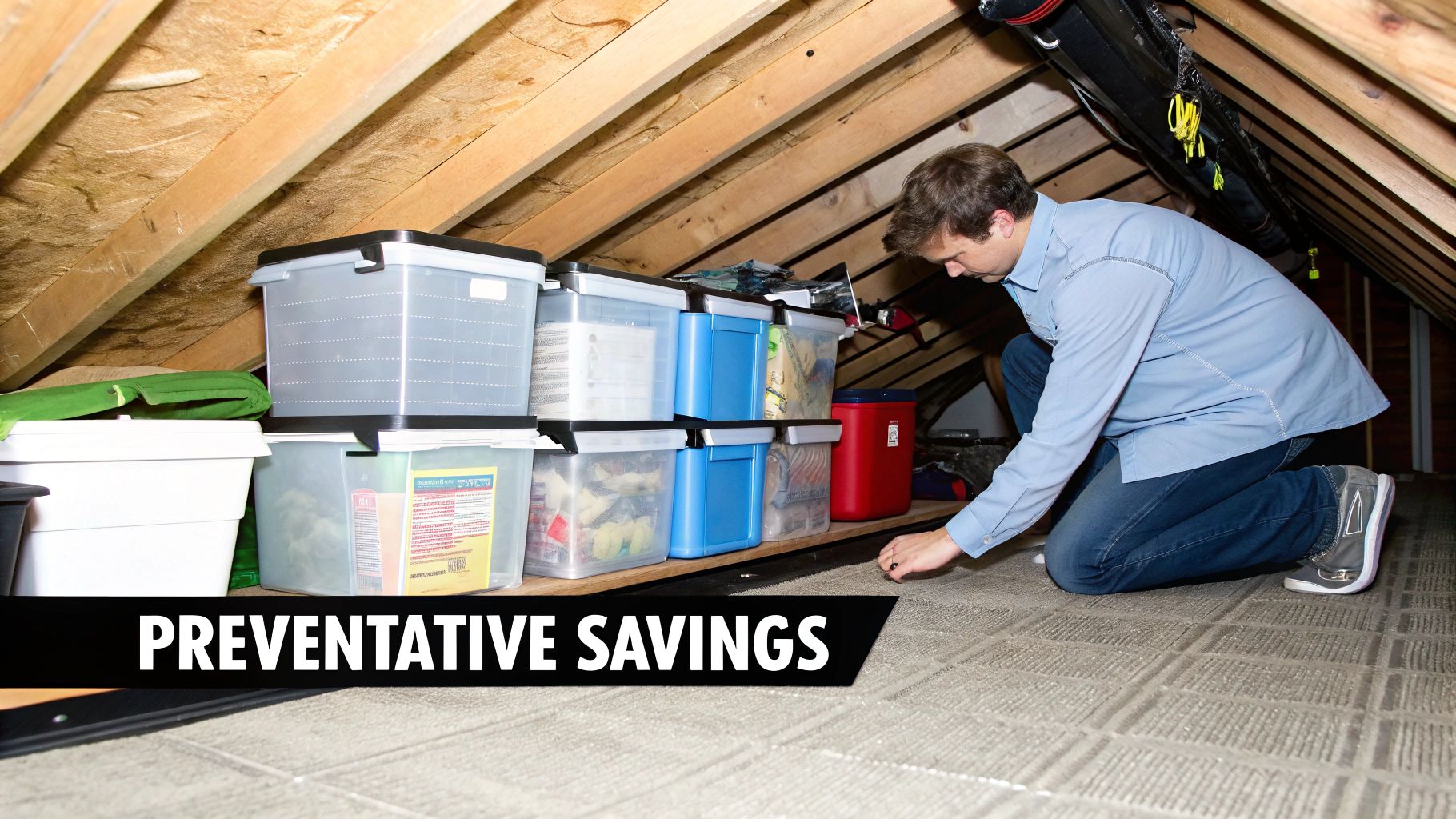
Calling in the professionals for a rat problem is always a smart move. But getting true value for your money goes beyond just picking the cheapest quote on the list.
You're investing in a lasting solution, not just a quick fix. Think of it as protecting your home's long-term health and your own peace of mind. Many of the same strategies for saving on home repairs apply here—the goal is to find that sweet spot between immediate cost and the long-term benefit of a job done right, the first time.
Your Pre-Hiring Checklist
Before you sign on the dotted line, it pays to do a little homework. A few pointed questions can save you from a costly mistake and help you find a genuine pro who will solve the problem for good. Don't be shy; any reputable company will be happy to give you straight answers.
Here’s what you absolutely need to ask any potential provider:
- Can I see your qualifications? Look for proof of certification from professional bodies like the British Pest Control Association (BPCA) or the National Pest Technicians Association (NPTA).
- What are your insurance details? They must have public liability insurance. This is non-negotiable, as it covers any accidental damage to your property during the treatment.
- What methods will you use? A good technician won’t just give you a generic answer. They should explain their plan—be it trapping, baiting, or a mix of both—and why it’s the right approach for your specific situation.
- Do you offer a guarantee? Ask what happens if the rats come back after they've finished. A solid guarantee usually lasts between 30 and 90 days.
A golden rule of thumb? Always get at least three detailed quotes. This isn’t just about comparing prices; it’s about comparing their approach, their professionalism, and how thoroughly they assessed the problem. A suspiciously low quote often means a corner-cutting service.
Preparing for Treatment and Maintaining Results
Once you’ve picked your expert, a little prep work can make a huge difference to how effective their visit is. Tidy up cluttered areas—especially in the loft, garage, or under the kitchen sink—to give the technician clear access. It helps them work efficiently and place baits or traps in the most strategic spots.
After the treatment is done, the job isn’t quite over. Keeping your home rat-free is an ongoing effort, and the most important part is prevention. Our detailed guide on how to prevent rats is a great starting point, covering everything from sealing up entry points to making your property less inviting.
Simple habits, like keeping bin lids sealed and clearing up garden debris, are what turn a one-off fix into a permanent solution. That’s how you get the best possible return on your investment.
Your Rat Control Questions Answered
When you're dealing with rats, it’s natural to have questions about what it’s going to take—and cost—to get rid of them. Let’s clear up a few of the most common queries we get from homeowners across the UK.
How Many Visits Will a Pest Controller Need for Rats?
A proper, professional job usually takes two to three visits. Think of it as a process, not a one-shot deal. The first visit is all about investigation—a technician will thoroughly assess the situation, figure out how the rats are getting in, and lay the first set of professional-grade baits or traps.
Subsequent visits, typically spaced a week or two apart, are where the real work happens. This is when the technician checks the traps, tops up the bait, and looks for signs that the treatment is working. For a really stubborn or large-scale infestation, a few extra visits might be needed to make sure the problem is completely solved.
Remember, multiple visits are a good sign. It shows the company is committed to a thorough job, targeting the entire colony—including any new arrivals—so the rats don't just come back a few weeks later.
Is It Cheaper to Handle a Rat Problem Myself?
Tackling a rat problem yourself can feel like a money-saver at first glance, but it’s often a false economy. The traps and poisons you can buy at a DIY shop simply don't have the same punch as the professional-grade stuff.
More importantly, a professional isn’t just there to kill rats; they’re there to diagnose why you have rats in the first place. Without that expertise, you’re just treating the symptoms. A failed DIY attempt can give the rat population time to grow, leading to more damage and a much bigger bill down the line.
Does Home Insurance Cover the Cost of Rat Removal?
Unfortunately, in almost all cases, standard home insurance policies do not cover the cost of pest removal. From an insurer's perspective, dealing with pests is seen as part of regular home maintenance, not an unexpected event.
However, it's worth checking the small print. Some more comprehensive policies might cover the damage caused by rats, like chewed-through wires or gnawed pipes. Always dig out your policy documents and have a proper read to see exactly what you’re covered for.
Don't let a rat problem spiral out of control. For a professional, evidence-based solution that tackles the issue at its source, contact Pest Predators Limited. Get your free, no-obligation quote today!

